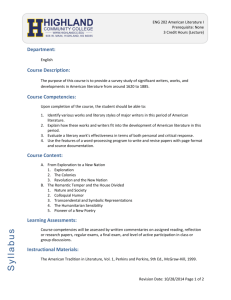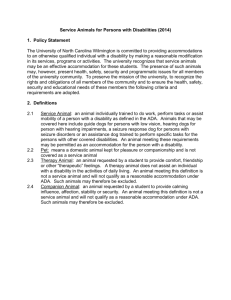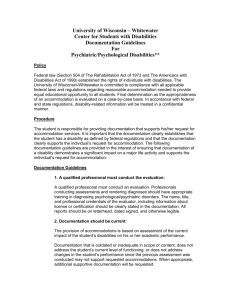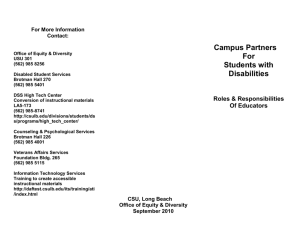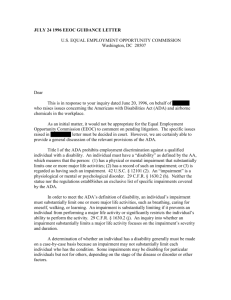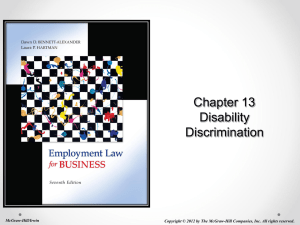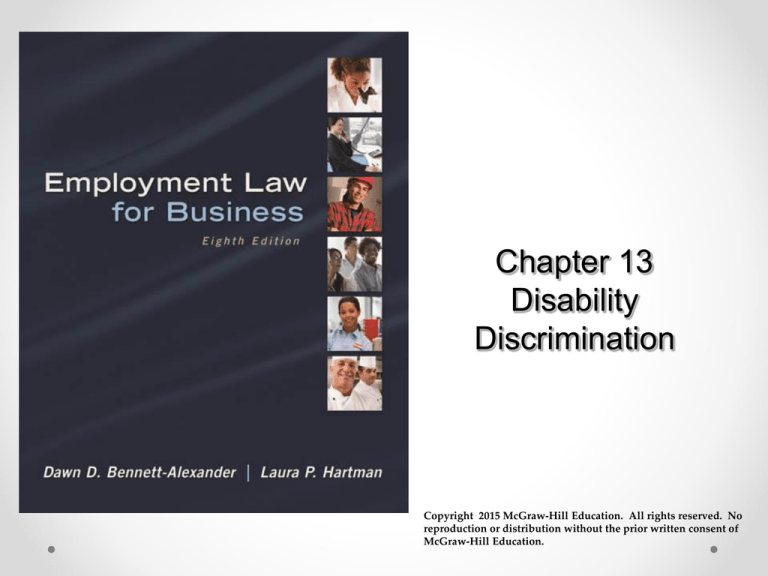
Chapter 13
Disability
Discrimination
Copyright 2015 McGraw-Hill Education. All rights reserved. No
reproduction or distribution without the prior written consent of
McGraw-Hill Education.
Learning Objectives (1)
Understand the environment for disabled
workers in today’s workplaces
Identify the challenges inherent in drafting,
interpreting, and enforcing a disability antidiscrimination statute
Outline the prima facie case for discrimination
under the Americans with Disabilities Act,
paralleled by section 504 of the Vocational
Rehabilitation Act of 1973
Learning Objectives
(2)
Describe the term disability as it is defined by
the ADA and be able to offer examples of
covered disabilities or disabilities that may not
be covered
Define major life activity and substantially limited
according to court decisions under the ADA
Explain how someone could be covered by the
ADA when they are not currently disabled, based
on having a record or perception of impairment
Learning Objectives (3)
Outline the burden-shifting framework of the
ADA and describe the defenses available to
employers under the ADA
Understand the operation of the ‘reasonable
accommodation’ and ‘undue’ burden concepts in
the ADA context
Appreciate the particular difficulties of handling
mental or intellectual disabilities under the ADA
Distinguish ADA from workers’ compensation
Removing Old Barriers
Workers with disabilities continue to face the
frustration of physical and attitudinal barriers,
with dire employment and financial impacts
“Nobody’s perfect” (well, almost) – 57M
Americans have 1+ physical/mental disabilities,
38M “severe” (12.6% of population)
Research: disabled workers, properly placed,
perform equally to able-bodied co-workers
Goal: employers “disability-blind” – factor-out
irrelevant or ‘accommodate-able’ traits
13-5
Vocational Rehabilitation Act (1973)
Applies to federal government workers and
contractors. Model for later ADA
Section 504: Prohibits discrimination against
otherwise-qualified individuals with disabilities by
any federal program or activity receiving federal
assistance
Sections 501, 503: Affirmative Action, with plans
based on size of contract, number of workers
13-6
Americans with Disabilities Act (1990) (1)
Applied Rehabilitation Act standards to many private
sector employers (15+ employees)
Increasing employment options for persons with
psychiatric disabilities
Supporting legislation that allows adults with
disabilities to retain Medicare coverage when they
return to work
State employees are not able to sue their state
employers under the ADA
13-7
Americans with Disabilities Act (1990) (2)
ADA protects the disabled from:
Intentional discrimination for reasons of social bias (DT)
Neutral standards with disparate impact on the disabled (DI)
Discrimination as a result of barriers of job performance that can
be fully overcome by reasonable accommodation
Some circuits have extended coverage to harassment
Under ADA and Rehab’n Acts, employers must take
proactive steps to make their workplaces amenable to
impaired workers (architectural accessibility standards,
and specific, job-related accommodations)
13-8
ADA: Prima Facie Case for
Disability Discrimination (DT)
To make a claim an employee must prove:
That she or he is disabled/has a disability
That she or he is otherwise qualified for the position
If an accommodation is required, that the
accommodation is reasonable
That she or he suffered an adverse employment
decision, such as a termination or demotion
Decision was based on discriminatory motive
13-9
“Disability:” Line-drawing
Disability: A physical or mental impairment that
substantially limits one or more of the major life activities
of an individual; a record of such impairment; or being
regarded as having such an impairment
Determination based on effect of impairment on life
“Correctable” disabilities
Pre-correction determination, except eyesight
Only ‘morbid’ obesity qualifies
Perception: includes disability-plus re hiring but does not
require accommodation of plus-factor. Scenario 2
Case: Barlow v. Walgreen Co.
13-10
“Major Life Activity”
Defining Major life activities: broad coverage –
these do not need to relate to job duties
Episodic impairments, depending on severity
“Substantially limits:” post-ADAA Act in 2008,
intends broad coverage, therefore low hurdle of
substantiality
Impairments may aggregate to reach limit
Obviously, a difficult employer ‘call’
13-11
“Otherwise Qualified”
Able to perform the essential elements of his or
her position (see next slide)
An employer may not consider possibility that
employee or applicant will become disabled or
unqualified for the position in the future
Was the applicant or employee qualified at the
time the adverse employment action was taken?
13-12
“Essential Functions”
Essential functions: those tasks that are
fundamental, and not marginal or unnecessary,
to fulfillment of the position objectives
Would removing the function fundamentally change
the job?
ADA vs. Title VII: extra inquiry into “essentiality”
Individual consideration vs. blanket exclusions
Business necessity, e.g. attendance
Samper v. Providence St. Med. Center
13-13
Direct Threat Issues (e.g., contagion)
Considerations:
The nature of the risk
The duration of the risk
The severity of the risk
The probability that the disease will be transmitted
and will cause varying degrees of harm
HIV/AIDS, PTSD, hepatitis C, diabetics
Scenario 1
13-14
“Reasonable Accommodation” (1)
Reasonable accommodation: An
accommodation to the individual’s disability that
does not place an undue burden or hardship on
the employer
The removal of unnecessary restrictions or
barriers
Can include investment in equipment, training
13-15
Reasonable Accommodation (2)
An accommodation does not have to be the best
possible solution
A disabled employee is entitled to reassignment
if he or she is qualified to fill a vacant position,
even if he or she can no longer perform the
essential functions of her or his own position
But Huber v. Wal-Mart: not a guarantee -- employer
may hire ‘best-qualified’
Interplay: reasonable accommodation and the
essential functions of a position
13-16
“Undue Hardship”
Undue hardship
Financial difficulty
Unduly costly, extensive, substantial or disruptive
Fundamentally alters the nature or operation of the
business
Greater than de minimis cost: most equipment or
telecom modifications cost < $500.00
“Fact-intensive” individualized consideration –
HR creativity and on-line resources!
13-17
Reasonable Accommodation and the
Contingent Worker
Both the staffing firm and the prospective
employer may be responsible for reasonable
accommodation
Tax incentives to eligible small businesses
Providing workplace access
Removing architectural or transportation barriers
Hiring “vocational rehabilitation referrals”
13-18
Requests for Accommodation and
Employer Reponses: Process
EEOC Enforcement Guidance
http://www.eeoc.gov/policy/docs/accommodation.html
Employee must inform his employer of a
disability and that an accommodation is needed
Interactive process
Case: EEOC v. Convergys
Employers should be promptly receptive and
responsive
13-19
Employee’s Responsibility for “Interactive
Process” (1)
Identification and Request for Reasonable
Accommodation: once an employee learns that
she or he will need some form of
accommodation in order to perform the essential
functions of her or his position, the burden is on
the employee to make a request for the
accommodation
13-20
Employee’s Responsibility for “Interactive
Process” (2)
Interaction
Meet with the worker
Obtain as much information as possible about the
condition
Discuss alternatives
Consider accommodations
Document the process
Right to medical documentation
13-21
Intellectual Impairments
EEOC guide on Intellectual Disabilities in the
Workplace http://www.eeoc.gov/facts/intellectual_disabilities.html
EEOC defines intellectual impairment:
IQ below 70-75
Significant limitations in adaptive skill areas
Disability originated before the age of 18
13-22
Psychological Impairments
26% of Americans have some manner of
diagnosable mental disorder
Difficult to see or comprehend, but effects as
real as anything physical or observable
Limits around insubordinate behaviors and other
job effects (e.g., attendance, team-working,
other ‘essential elements’)
Significant role for qualified medical
professionals
13-23
Handling Addiction
Addiction can be a disability – same rules
Employer needn’t accommodate abuse on-thejob, nor effects of addiction that may go to
‘essential elements’
e.g., chronic tardiness due to alcohol abuse
Reasonable accommodation for countermeasures
e.g., meetings, possible in-patient treatment
13-24
Disability Harassment
Workplace harassment prohibited when it
creates a hostile environment against disabled
workers
Low incidence of cases, but Title VII serve as
model
“severe or pervasive” enough to alter terms of
employment has been primary controversy
No Supreme Court precedent yet
13-25
Additional Responsibilities of Employers:
workers compensation
“Potential responsibility” or liability of employer
“No fault” liability: worker’s compensation
A remedial history: purpose of worker’s compensation
General statutory scheme
Payments into common fund per experience rating of work
Injured employee may not sue employer
Expedited, schedule-based payments to injured employee
Injury arising “out-of or in the course of” employment
13-26
Miscellaneous
Retaliation forbidden under ADA but remedies
limited to equitable relief (e.g., reinstatement)
Genetic testing: taking or using information
forbidden in employment decisions (GINA)
Ability to measure outstrips ability to understand
implications
Some overlap between ADA leaves-of-absence
and Family Medical Leave Act (FMLA)
See coverage in Chapter 16, infra
13-27
Management Tips (1)
Never assume the physical or intellectual
limitations of a worker with disability
Review all job descriptions to make sure that the
job requirements are actually required to
complete the job
Consult with the employee by asking questions
Be clear on the rules for when medical
examinations can be required of a disabled
person
13-28
Management Tips (2)
Review all application materials to ensure that
there are no inappropriate questions concerning
irrelevant abilities
Negotiate and make fair and reasonable
counterproposals
Ensure that all decision-makers understand
what constitutes notice of a request for
accommodation and what rights are triggered by
that request
13-29

